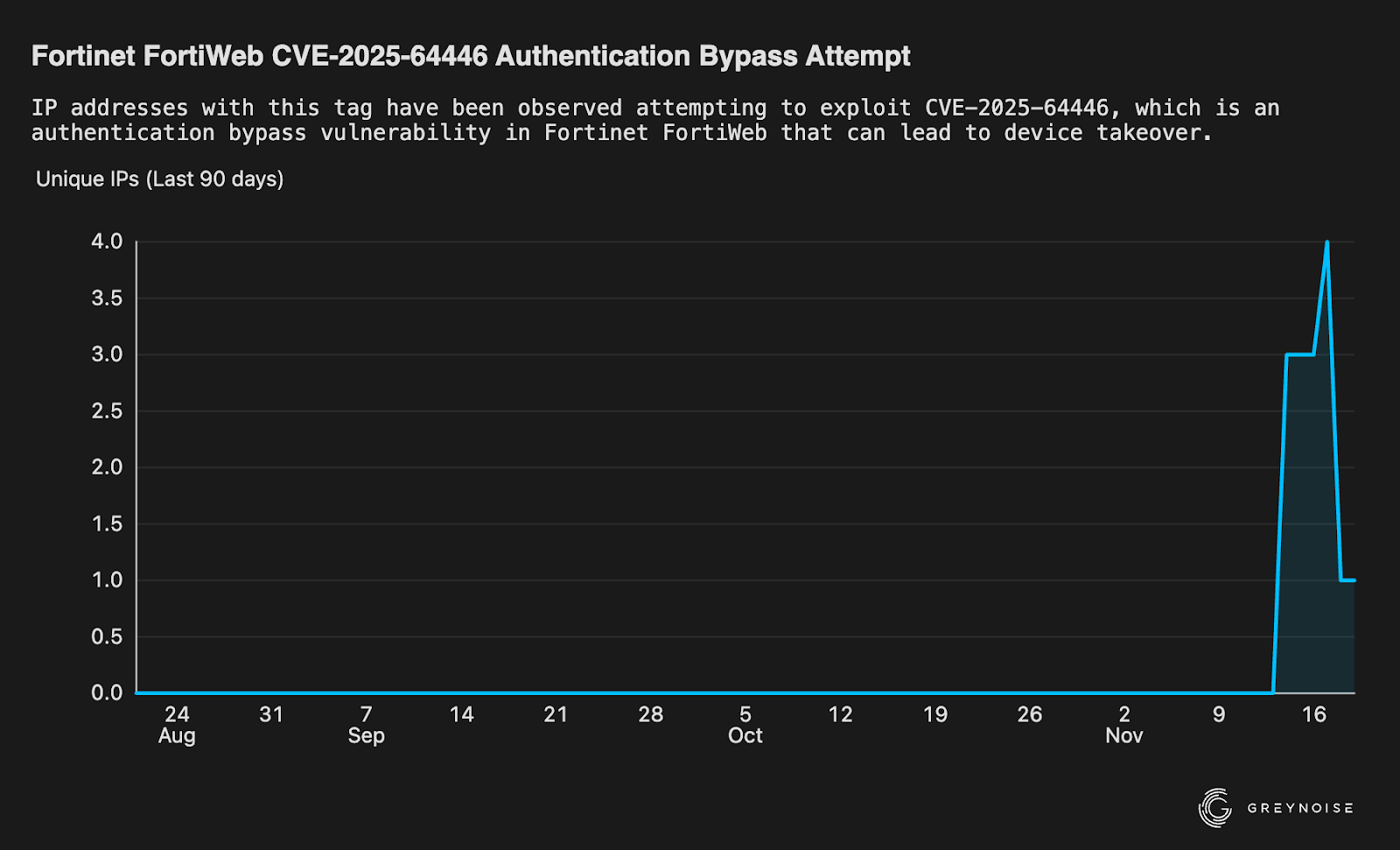GreyNoise has begun seeing active exploitation of CVE‑2025‑64446, the critical path‑traversal flaw that lets an unauthenticated actor run administrative commands on Fortinet FortiWeb appliances. The vulnerability landed in CISA’s KEV catalog on November 13th, and within roughly 72 hours, our global honeypot fleet was met with crafted requests aimed at a range of FortiWeb versions (7.0–8.0). The story is as old as time: the patch notes went out, and a [coordinated] group of scanners has already started weaponising the flaw.
The flaw in a nutshell
FortiWeb’s management API accepts a traversal string that can be abused to reach the internal cgi‑bin endpoint, for example:
/api/v2.0/cmdb/system/admin%3f/../../../../../cgi-bin/fwbcgi
When that endpoint is hit, the attacker gains the ability to execute privileged operations. The first exploit traffic hit our sensors on November 17, 2025, confirming a rapid weaponization cycle that matches the speed we typically see with high-impact edge-device vulnerabilities.
What the wire is telling us

Our sensors observed eight distinct IPs probing at least six different JA4T (TCP) fingerprints and two JA4H (HTTP) fingerprints. Although the window sizes and MTUs vary, the ordering of TCP options (2‑4‑8‑1‑3) and the overall stack profile point to modern Linux‑derived clients rather than home routers or IoT devices. The TLS handshakes, however, were remarkably uniform: the dominant JA3 fingerprint is 9b72665518dedb3531426284fdec8237, a pattern we typically see from Python requests, libcurl‑derived stacks, or Firefox‑derived TLS libraries. In short: the same TLS implementation is being reused across multiple HTTP modules.
The infrastructure is spread across seven hosting providers—Flyservers, Clouvider, DigitalOcean, Kaopu Cloud, WorkTitans, InterHost, and HOSTKEY—with no residential, mobile, or commercial VPN presence. This distribution is classic for operators seeking resilience and deniability rather than a hobbyist “botnet‑of‑the‑week”.
User‑agent strings further betray the tooling. Some nodes cycle through hundreds of synthetically generated browser signatures, while others plainly identify themselves as python-requests/2.25.1 or node.js. A few even toss in Log4Shell‑style JNDI probes, indicating opportunistic hunting beyond just FortiWeb.
Who is pulling the strings?
The behavior aligns with initial‑access brokers and ransomware affiliate group patterns: rapid adoption of a high‑value CVE, large‑scale scanning, multi‑CVE probing on the same hosts, and an infrastructure deliberately dispersed across unrelated providers. Three of the observed IPs have a history of scanning for a laundry list of other enterprise edge vulnerabilities (CrushFTP, Confluence OGNL, Sophos XG, ColdFusion, Ivanti Connect Secure, etc.). That indicates the possibility that this Fortinet weakness will be added to the same attacker pipelines.
Current activity
So far, the traffic we see is limited to environment discovery, version validation, traversal attempts, and occasional multi‑port probes (443, 8443, 8080, 9443, 10443). We have not yet captured a successful post‑exploitation payload in our deception environments, but the attack surface is large enough that a “scan now, exploit later” approach is entirely plausible. Three source IPs — 193.182.144.250, 38.60.203.31, 46.17.103.97 — notably drew additional attention on our Fortinet Network Security Appliance sensors. According to Censys, 38.60.203.31 and 46.17.103.97 are classified as being located in bulletproof hosting (you’ll need to use the Censys’ new cencli tool to see that label, which does not appear in the Platform UI).
What defenders should do right now
Block these IPs
GreyNoise Block is a fast and easy solution that includes an out-of-box blocklist tracking malicious IPs targeting Fortinet systems. Search for ‘Fortinet’ in the Template Search Box. You can modify the template to specify source country, other IP classifications, CVE ID, CIDR block, etc. New users can get started with a 14-day free trial.
For customers who need a more targeted blocklist (specifying ASNs, JA4, destination country, etc), GreyNoise now supports full query-based blocklists leveraging the entirety of GreyNoise query parameters.
Patch now
Fortinet’s fixes are available; any FortiWeb management interface exposed to the Internet should be updated without delay.
Audit your logs
Look for any of the following: traversal strings (../, %3f), unauthenticated POSTs to /api/v2.0/cmdb/, hits on /cgi-bin/fwbcgi, sudden spikes in user‑agent diversity, or requests originating from the hosting providers listed above.
Lock down the management plane
if the admin interface is public, assume it’s already been probed. Move it behind an allow‑list, VPN or bastion host, and keep it off the public Internet whenever possible.
Enable detailed logging and retain it for forensic use
If an exploitation attempt succeeded before patching, you’ll need that data to understand the breach.
Looking ahead
GreyNoise will keep an eye on this campaign for a shift from reconnaissance to active post‑exploitation, for any movement onto new hosting providers, for tooling changes, and for the appearance of FortiWeb access listings on underground markets. The current signals suggest this is not a short‑lived flash of interest but a persistent inventory‑building operation targeting enterprise edge devices.
If you run FortiWeb, treat CVE‑2025‑64446 as an immediate operational risk. Patching and proper network segmentation are no longer optional—they are the line between staying off a threat actor’s target list and becoming the next compromised foothold in a larger access‑bundle.









.png)
